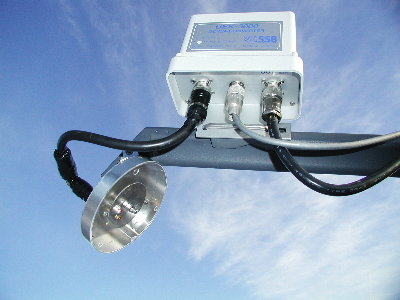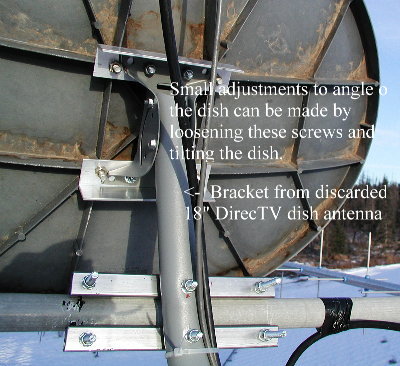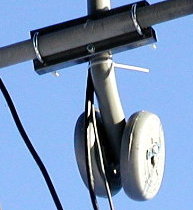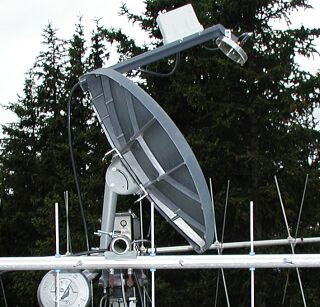

OSCAR 40 (AO40) 2.4 GHz Antenna
Patch Feed and Downconverter Mounting
The photo illustrates the details in mounting the patch feed and the downconverter on the feed arm of the dish antenna. The patch feed is held in place by two small strips of "plumber's tape". The mounting holes are pre-drilled in the patch feed, and the mounting bolts on the feedarm are already in place - it's a simple matter of bolting them together so the patch feed is "square" to the end of the feed arm, and aimed at the dish antenna. Small movements to adjust the feed placement are possible due to the flexibility of the plumber's tape.

OSCAR 40 (AO40) 2.4 GHz Antenna
Mast Mounting Bracket and Adjustment
The dish support mount came from a discarded 18 inch DirecTV antenna. I removed all mounting brackets from the PrimeStar dish, then cut two lengths of aluminum "L" bracket and drilled them to acfept the dish and the mounting bracket. I also drilled the mounting bracke to accept two lengths of 1 inch square tubing, which was then bolted to the mast using two u-bolts. The DirecTV mount is adjustable after the anenna is bolted in place, by loosening the screws on the throat of the mount and tilting the antenna up or down, as needed. I found that after I initially put the antenna in place, no further adjustment was required.

OSCAR 40 (AO40) 2.4 GHz Antenna Counterbalance
(Finally - a use for your old weight set!)
You must use a counterbalance to ease the load on your rotor, as well as make it easier to keep the antenna aimed where you want it. The windload on this antenna can be very heavy, causing it to move around. The counterbalance helps alleviate this. I use two old dumbell weights. A hole drilled through the bracket and a long bolt to hold them on are all that is needed. The weights total nearly 10 pounds.

The Final AO40 2.4 GHz Antenna Installation
Remember the physics class you took somewhere along the line in school? The angle of incidence equals the angle of reflection. The dish is aimed approximately 45 degrees toward the sky, resulting in the 22.5 degree angle offset being aimed at the horizon. Good luck with your project!